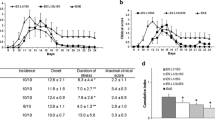Abstract
Using adult mice infected with the trematode Schistosoma mansoni, we observed that this infection induces both thermal hyperalgesia and an increase in the levels of nerve growth factor in the paws. To explore the mechanism involved in peripheral hypersensitivity during chronic infection, mice were infected with 60 cercariae of S. mansoni and injected 17 weeks later with nerve growth factor, anti-nerve growth factor or with other molecules known to be associated with hyperalgesic processes. The results of these studies showed that antibodies against tumor necrosis factor-α, but not against nerve growth factor, reduce thermal sensitivity in schistosome infected mice, suggesting that this cytokine but not NGF plays a crucial role in schistosome-induced thermal hyperalgesia. Treatments with anti-inflammatory drugs support this hypothesis.
Similar content being viewed by others
Author information
Authors and Affiliations
Additional information
Received: 11 February 1997 /Final version: 16 May 1997
Rights and permissions
About this article
Cite this article
Aloe, L., Moroni, R., Angelucci, F. et al. Role of TNF-α but not NGF in murine hyperalgesia induced by parasitic infection. Psychopharmacology 134, 287–292 (1997). https://doi.org/10.1007/s002130050451
Issue Date:
DOI: https://doi.org/10.1007/s002130050451




